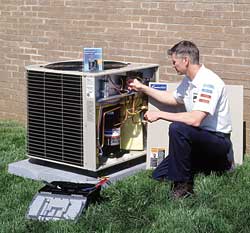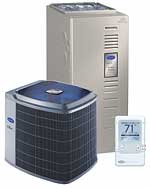
Although HVAC manufacturers have not referred to their product redesigns as makeovers, some of the changes have the potential to fit in that category quite well. They have gone from drab to fab, dreary to cheery, bleak to chic, with the potential to break away from the pack.
Take, for example, some new residential lines from York International Corp. Doug Widenmann, director of marketing for York International (York, Luxaire, and Coleman), said the company had been working with its existing product lines for the last few years.
"Echelonâ„¢ [Coleman] and Affinityâ„¢ [York] fill the greatest void for high-end products," he said.
They were completely redesigned from the ground up, using dealer input, consumer surveys, and industrial and market designers to create a new look, as well as improved dealer features. In this instance, Affinity Series air conditioners, heat pumps, and furnaces were "designed from the ground up to meet the demands of savvy, style-conscious consumers."
There are plenty of other examples of high-end products gone high tech.
Image Awareness
"Design and aesthetics have never played a more important role in consumer goods," noted Andy Fracica, York brand marketing manager."So, the Affinity Series 12- and 13-SEER units arrive with something never seen in the industry before - a choice of six exterior colors to complement consumers' homes, landscaping, and lifestyles."
Homeowners can choose from champagne, stone, terra cotta, bermuda, gun metal blue, and jet black. The design includes a tightly patterned coil guard, designed to increase safety and protect the coils from the elements.
According to the company, the G90 steel cabinetry is power painted to withstand a 1,000-plus-hour salt spray test, and the 2- to 5-ton units offer "increased durability in the harshest environment." The line also features a rustproof composite base pan.
High-efficiency scroll compressors have been isolated behind a composite material that does not rattle or vibrate. This was designed to enhance reliability and contribute to the units' quiet operation. The fan design helps to make the units among the quietest in the industry, the company said.
The Echelon also was designed with a distinct image in mind. The top grille even bears a resemblance to a barbecue grill - a nod to the traditional Coleman product image.
According to the manufacturer, the unit has a minimum efficiency of 12.5 SEER. It offers two levels of coil hail protection, sealed contactors with lugs, a polymer mesh coil finish, low sound and vibration, a composite base pan, Whisperdriveâ„¢ two-stage compressor, and "automotive-quality logos," said Widenmann.

Yes, It's A Commodity
In addition to winning market share, Widenmann said the company is looking to expand its dealer base and distribution. One of the company's biggest advantages, he said, is how different the Coleman, Luxaire, and York lines all look from each other."They all look different. Each dealer group thinks theirs looks the best," he said. "More goes into selling high-end product." He noted that these extensive product redesigns "allow the appearance of product to be a feature."
"This is a product-driven industry," Widenmann said. "Product-driven industries differentiate by price. Market-driven industries differentiate by brand, tag lines, appearance, and real features."
Claims of quality, reliability, and comfort "are in everyone's message," he said. "When everyone sends the same message, it has no real value, no real impact.
"We did it right. We didn't hang jewelry on our product. We redesigned from the ground up."
York executives have stated openly that residential HVAC products, the items they produce, are a commodity. It's what the contractor brings to the table that is not a commodity. Their service, commitment, after-sales service, helpful staff, consumer financing, extended warranties, service agreements - "That's how they sell themselves and not a commodity," said Widenmann.

Smart Systems
International Comfort Products' Tempstar® SmartComfort™ 2400 Series split-system heat pumps are the brand's latest top-of-the-line products. The company said the series can provide 14-SEER efficiency when matched with selected coils. They are available in 2- through 5-ton capacities.When matched with a variable-speed air handler or furnace, the heat pumps provide even greater comfort control, the company said. Additional features include:
Tempstar 2200 Series heat pumps feature "a thicker fin coil that offers aesthetic improvement, as well as helping prevent accidental damage in transporting and handling," the company said.
Available in 1.5- through 5-ton capacities, the 2200 heat pumps provide 12-SEER performance. Heating mode efficiencies are rated up to 8.6 HSPF.
Meanwhile, the Rheem and Ruud 90 Plus modulating furnace with Contour Comfort Control offers what the company called, "North America's first truly modulating gas furnace." According to Adam Schuster, the company's product manager for Residential Heating Products, the furnace is a step above the rest.
This particular furnace is de-signed to modulate from 40 percent to 90 percent at 13 different stages. Schuster said that the first step is from 40-percent to 50-percent capacity. After that, the furnace steps up in 5-percent increments, he said. Its accuracy is designed to 0.5 degrees of setpoint.
"Not only does it keep the condition of the space, but the temperature rise is always constant," he said.
The product won an International Air-Conditioning, Heating, Refrigerating Exposition (AHR Expo) 2004 Innovation Award and is installed with a smart thermostat.
"When there is a call on W1," Schuster explained, "the furnace operates at 40-percent capacity.
According to Schuster, if the thermostat is not satisfied in five minutes, the furnace in-creases to 65-percent capacity. He said if the temperature isn't satisfied in another five minutes, it goes to 100 percent. The 65-percent stage, therefore, actually has a substage designed into it that allows it to increase to 100 if needed, he said.
With a single-stage thermostat, the 90 Plus furnace starts at 40 percent; after five minutes, it may increase to 65 percent; and after another seven minutes, may increase to 100 percent.
That 40-percent stage, therefore, has two sub-stages, explained Schuster.
High-End Diagnostics
Ed Lightner, product specialist supervisor at Rheem, said higher-end equipment also offers advanced diagnostics using an LED code for fault detection, to "take the guesswork out of system troubleshooting."The Mod 90, for instance, features control boards with LED displays. It stores fault codes up to five days, Lightner said, making it possible for technicians to spot trends or processes.
The trend of using advanced electronics in residential systems isn't new for 2004, but it isn't too much older than that. When the UltraTechâ„¢ Home Series launched at the 2003 AHR Expo, Emerson Climate Technologies positioned these products as the HVAC industry's most-advanced, energy-efficient heating and cooling technologies.
Since then, the company said it has continued to move UltraTech forward with the addition of new products. One year later, the company said advanced technologies work even better, with new, integrated product benefits that "protect the compressor, support the contractor and service technician, and bring a new dimension of comfort and control to homeowners."
"Comfort Alert Diagnostics," with the "Active Protection" thermostat from White-Rodgers, were introduced this year. The diagnostic system communicates directly with the thermostat, alerting homeowners when a problem occurs within their A/C system, the company said.
"When combined with the diagnostic technology and a Copeland Scroll compressor, the thermostat can automatically shut down the compressor when severe compressor damaging faults occur," said the company.
The product has been incorporated into high-end equipment by manufacturers such as Nordyne and Lennox.
It's An Evolution
The nature of home HVAC products has evolved and will continue to do so. The changes are being driven partly by efficiency requirements and partly by the increased adaptability of high-tech electronics.The cornerstone of Bryant's Evolution® system is a variable-speed gas furnace or fan coil, the company said.
Smart electronics keep track of previous cycles, allowing the system automatically to select the correct furnace settings for the best possible combination of comfort and energy efficiency; in short, the system "learns," said the company.
The system can be added to any Bryant air conditioner or heat pump, the company said. For maximum comfort, efficiency, and system connectivity, Bryant recommends using the system with the Two-Speed Puron Plus®, which offers low-speed cooling operation for savings and humidity control.
The system's enhanced humidity control (the "Perfect Humidity" system) is said to help homeowners use less energy by allowing them to feel comfortable at higher set temperatures in summer and lower set temperatures in the winter.
In functionality and appearance, today's high-end HVAC equipment is looking pretty good. You could say the makeovers will pay for themselves.
Publication date: 06/28/2004

Report Abusive Comment